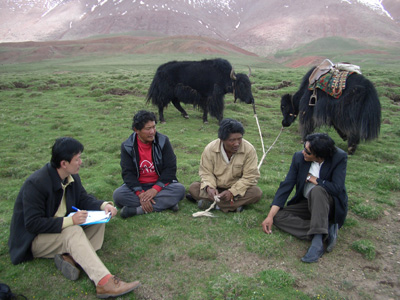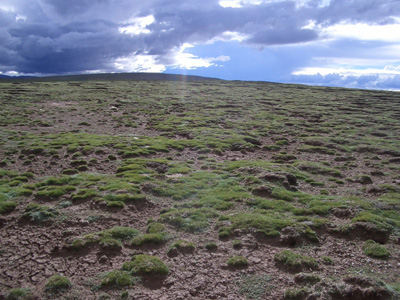
Interview Herdsmen

The grassland degeneration in the Source Region of the Yangtze River
The Tibetan Plateau, the roof of the world and the third pole of the earth, one of the most imposing topographic features on the Earth’s surface, is very sensitive to climate change, which has been recognized in past researches. Its complex landform with high altitude, powerful monsoon circulation and solar radiation make it sensitive to temperature change, which shows that the amplitude of its temperature change is large. Compared to other regions, climatic change in the Plateau is earlier. The Plateau is regarded as a sensitive region to global climate change. The ecosystems on the plateau including wetland respond to global warming rapidly and obviously. Previous research revealed that the glacier and ice cap on the high mountains retreat significantly in the past five decades, which have dramatically impacts on the hydrological regime, temporal and spatial water distribution and availability, water chemistry in the whole river basins. It’s also found that the swamp in this area is shrinking rapidly. In the last two decades, 647 km2 of swamp in the Yellow River source area shrunk and dried up. These changes, both as the result of and response of ecosystems to regional climate change, will directly affect wetland ecosystem, local communities and people living downstream as well.
The Yangtze Source Area is located in the center of the Tibetan plateau, which has an average altitude of 4000 masl and the largest ice mass outside the Earth’s two polar regions. Besides glaciers and snow, the natural coverage of this area also includes alpine steppe, alpine meadow, grassland, swamp, and alpine shrubs.
To address the situation, World Wild Fund (WWF) China supported a project of "Climate Change and Its Impact in the Source Region of the Yangtze River" from 2004 to 2005. The project aimed to integrate climate change into regional planning process for sustainable development in a relative long-term perspective. This project was thus an effort to link important global climate issues with a regional setting in China, as an example of integrating interdisciplinary studies on climate change with adaptation policies and actions in developing countries.
Based on field work in three kinds of the grasslands high-cold marsh meadow, high-cold grassplot meadow, and high-cold steppe meadow of the Source Region of the Yangtze River in 2005, we have some main findings in the following:
1. Climate change was very obvious in the Source Region of the Yangtze River
Among 200 interviewees, most of them (84.50%) realized that it had the most obvious or more obvious climate change in the Source Region of the Yangtze River. In particular, 56.39% of herdsman interviewees recognized that it had the most obvious climate change in the local grassland.
In the Source Region of the Yangtze River, interviewees thought that the distinguishing influences of climate change on local ecosystem included precipitation (14.72%), the plague (13.40%), grass quality (13.21%), and grassland (10.00%).
This means we need to pay more attention to climate change in the Source Region of the Yangtze River, and it is valuable to research the topic of climate change there.
2. Serious harmful influences of climate change on husbandry in the Source Region of the Yangtze River
The local herdsmen’s husbandry and living depends on the climate. So, they are very sensitive to climate changes.
After our visiting one household by one household, we found that the local herdsmen are more sensitive to climate changes in warm season than in cold season, because in warm season grass turn green and grow up, and it is also the important period for livestock growing, calving, lambing and milking. In term of shorter in warm season than before, the local herdsmen explained that the period of warm season were 3-4 months before, but it become only 2 months and more. This climate change has influenced strongly not only grass turning green and growing up, but also livestock growing, calving, lambing and milking.
In the Source Region of the Yangtze River climate change influenced harmfully not only on ecosystem, but also on husbandry. In general, interviewees thought that climate change influenced harmfully and obviously on the three aspects of husbandry: grass quality worsening (15.69%), the plague insect pest increase (14.78%), and illness of livestock increase (10.77%) as well.
The local herdsman’s husbandry had been influenced harmfully by climate change. Some herdsmen had very difficult situation. It means that we need to pay more attention to the herdsman’s husbandry and their living condition because of the great climate change.
3. Serious harmful influences of climate change on ecosystem in the Source Region of the Yangtze River Grassland has the closest relation with herdsman’s husbandry and their living condition in the Source Region of the Yangtze River. Unfortunately, the local grassland has degenerated, desertized and decreased.
86.50% of 200 interviewees pointed out that the grassland degeneration or desertization was in the most serious situation (52.50%) or the more serious situation (34.00%) in the Source Region of the Yangtze River. 92.50% of them recognized that there was the closest relation (61.00%) or closer relation (31.50%) between climate change and grassland degeneration or desertization.
72.00% of 200 interviewees realized that the grassland decrease was in the most serious situation (44.00%) or the more serious situation (38.00%) in the Source Region of the Yangtze River. 87.50% of them agreed that there were the closest relation (52.50%) and closer relation (37.00%) between climate change and grassland decrease.
Overall, interviewees thought that four aspects of climate change influenced harmfully on ecosystem, which included grass quality worsening (20.87%), the plague increase (17.46%), desertization (13.66%), and grassland decrease (10.44%).
As victim, many herdsmen told us that because the ecosystem became worsen, the livestock grew up and calved difficultly, and had less lambing and milking.
Therefore, we need not only pay a attention to the local ecosystem worse, but also pay more attention to influences of climate change on ecosystem, which focused on the local herdsman.
4. Different influences of climate change on ecosystem in different areas
The Source Region of the Yangtze River is an area with a vast territory. There are different climate changes in different areas, there are different influences of climate change on ecosystem in different areas.
On the one hand, there are different climate changes in different areas. For example, in Zhiduo County, the most distinguishing changes were less snow than before in cold season and more snow than before in warm season. However, in Qumalai County, the most distinguishing changes were more gale than before in both cold season and warm season.
On the other hand, there are different influences of climate change on ecosystem in different areas. Among three kinds of the grasslands, higher percentage of interviewees in both high-cold marsh meadow (16.55%) and high-cold steppe meadow(17.84%) thought that the most harmful influence of climate change on husbandry were grass quality worsening. However, 17.99% of interviewees in high-cold grassplot meadow recognized that it was the plague and insect pest increase.
In a word, when we do the project on ecosystem protection in the Source Region of the Yangtze River, we should think about both different climate changes and different influences of climate change on ecosystem in different areas.
5. It is not true that over husbandry resulted in ecosystem worsening in the Source Region of the Yangtze River
In many newspaper reports, government report and research paper, reporters (included journalists, officials, and scholars) pointed out that over husbandry (that is, herdsman has too much livestock.) was one of important factors resulted in ecosystem worsening in the Source Region of the Yangtze River.
However, when we did this survey in the Source Region of the Yangtze River, both many local herdsmen and a husbandry official told us that herdsmen hadn’t too much livestock. 42.50% of interviewees thought that there was not over husbandry here. The local herdsmen and husbandry officials also told us similarly that the amount of the livestock hit an all-time high before the great snow disaster in 1985. Since then, the livestock here never reach the peak. The amount of the livestock has not increased but decreased.
In the Source Region of the Yangtze River, in general herdsman has not too much livestock. In fact, in some areas ecosystem worsen resulted in that herdsmen have too much livestock or their husbandry methods are unsuitable. But those are only some cases or partial problem, but not a widespread and serious problem.
In general, too much livestock and unsuitable husbandry methods are not main factor resulted in ecosystem worsening in the Source Region of the Yangtze River. So, it is valuable to survey and study the violent climate change and the fragile ecosystem in the Source Region of the Yangtze River.
Overall, Climate change was very obvious in the Source Region of the Yangtze River. It has not only obvious harmful influences on ecosystem but also serious harmful influences of climate change on husbandry. In a sense, this project -- social science survey on "Climate Change and Its Impact in the Source Region of the Yangtze River" not only has its own academic value, but also correct a wrong theory "over husbandry resulted in ecosystem worsening in the Source Region of the Yangtze River".
ADDRESS:
Prof. & Dr. Zhang Jijiao
Institute of Ethnology and Anthropology, Chinese Academy of Social Sciences
No.27, Zhongguancun Nandajie Road, Beijing 100081, P. R. China
E-mail: Zhjijiao@sohu.com